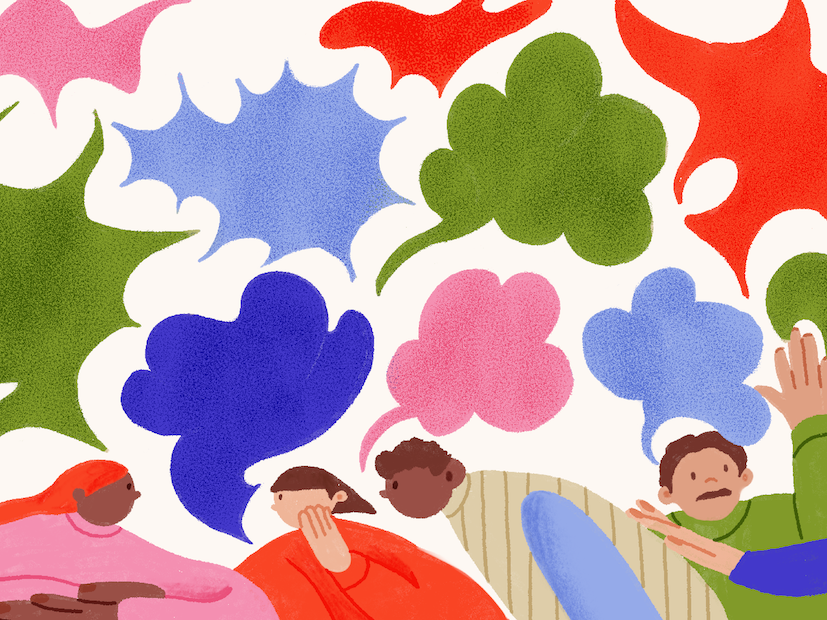Developing decision-making structures - How we organise our collaboration

In this article, we show how we organise ourselves internally. We describe the structures we use to promote co-determination and distribute power.
In our work, we strive for a democratic, sustainable and resilient future based on openness, participation and transparency. In order to live up to this aspiration within our organisation, we need to organise our internal collaboration accordingly: we need a solid governance model.
A governance model is a plan for how people in a group make decisions. It regulates questions such as: Who is allowed to decide what? Who is responsible for what?
Our governance model should express our values and fit our complex structures.

OKF’s current governance modell (2025)
Structure: Association, team, projects & communities
The general meeting and board are the statutory bodies for our association under German law. The general meeting takes place once a year. Our volunteer board advises on strategy, provides input, monitors and supports the management.
The management team consists of the managing director and a small team that takes care of organisation-wide finances, human resources, technical infrastructure and organisational development. In addition, the management’s Policy Team works on open data and democratic digital policy, e.g. with other organisations in the F5 alliance. They regularly make policy demands and publish position papers, among other things. The management team brings together insights and experiences from all projects and derives strategic and operational measures.
The majority of our colleagues work on our major projects FragDenStaat, Jugend hackt and Prototype Fund. These areas operate independently: they have a strong identity, their own communities, raise their own funds, set strategic goals and decide on their own staffing. We have set out in writing how decision-making powers are divided between management and project management. The large projects are partly like organisations within the organisation. In addition, there are also smaller projects, e.g. on open education and hardware, and the Code for Germany network.
In our diverse communities, there are many people who are not part of our organisation but are an integral part of our everyday life: long-standing project partners, committed volunteers, supporters, national and international networks.
Instruments for co-determination
To enable participation at all levels, strengthen projects and relieve the burden on management, we have set up cross-project committees.
The personnel development circle deals with issues relating to cooperation in the office, the organisational climate, team activities, further training and employee benefits. In the communication circle, communication officers from all projects regularly exchange ideas on campaigns, public relations and tools.
Each circle has around six voluntary members (all major projects and the management team are represented) and meets for an hour every two weeks in the office or online. The circles have the mandate to make small decisions themselves, such as establishing rules for cooperation in the office. For larger issues and decisions with financial implications, the circle prepares a basis for decision-making. The circle members collect requests and suggestions from the team, develop proposals and forward them to the relevant departments, such as management or the decision-making forum (see below for more information).
In our experience, the circles work well as a peer-to-peer learning space, a forum for exchange between projects, an innovation tool and a crisis instrument. However, the circles are not suitable for managing ongoing, critical infrastructure or carrying out large conceptual work. This requires dedicated positions, which are located in our management team.
The decision-making forum makes cross-organisational decisions that go beyond the direct area of responsibility of the management, such as proposals from circles or large project initiations. It consists of senior representatives from all areas and the management. The committee can vote asynchronously in writing or meet for a call.
Guidelines and exchange formats
We have a number of policies and guidelines. These include our code of conduct and our whistleblowing policy.
Our internal handbook and accompanying guidelines contain as much information as possible in writing: from the contact details of our caretaker and best practices for grant applications to an overview of our salary model. The management team maintains the handbook, but every team member can access it, correct errors and make additions (and notify the caretaker immediately if, for example, a ceiling light in the conference room is broken). This reduces the workload of our small administrative team, makes knowledge less dependent on individual employees and helps new colleagues find their feet more quickly.
We have special exchange formats to maintain and discuss our organisational culture and gauge the mood: we learn from each other at the Know Lunch, discuss complex issues in a discussion forum, and go on an annual OKF team retreat to the countryside.
Our internal structures are never finished; they evolve with us. We have to continuously reflect and adapt. By the time this article is finished, we may already be trying something new.
Why all this?
A good governance model…
… reflects our complexity. We have self-sufficient project teams, numerous networks, cooperation between full-time and volunteer staff, and diverse communities. The individual elements in our governance model help us to coordinate everything and hold the organisation together as a whole.
… distributes power. The model distributes decision-making power, reduces dependence on individuals and allows decisions to be made on the basis of broad knowledge.
… is resilient. A wide range of tools helps us to respond quickly to changes such as new projects, crises or issues of trust.
… continues to evolve. Governance is a tool that we constantly question, evaluate and adapt. It is a living framework that moves with us instead of holding us back.
… conserves resources. The model saves time and energy because we don’t have to renegotiate every decision, but can fall back on existing structures and processes.